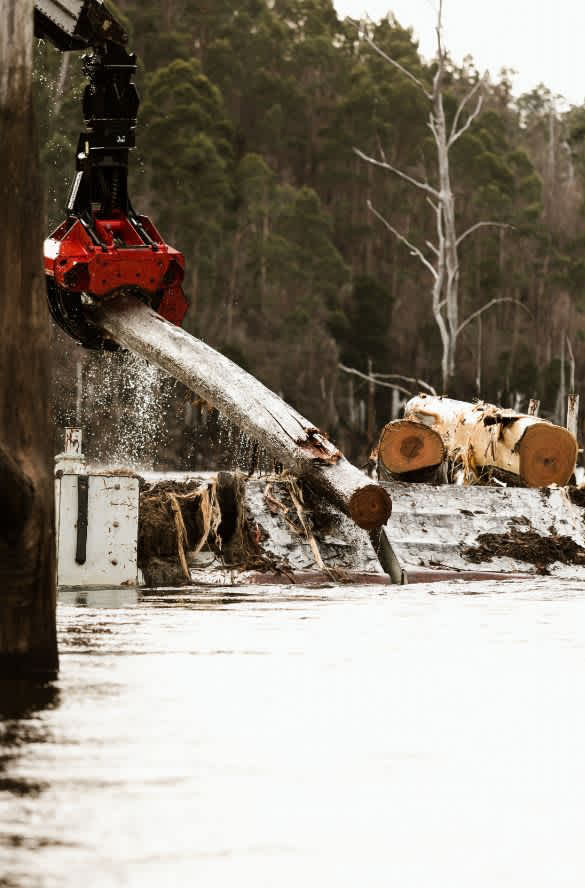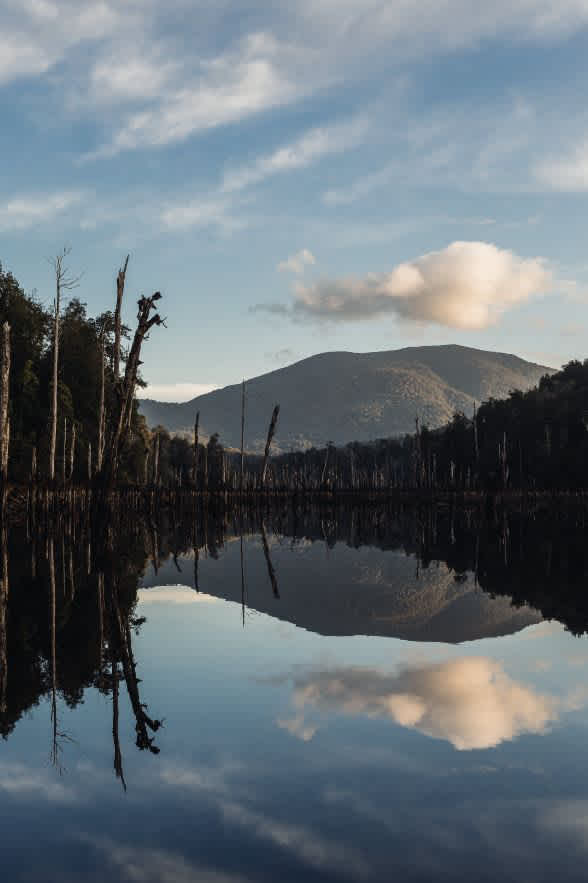Tip of the iceberg for hydro timber entrepreneurs
07 July 2021
Nicole Bittar
The Hydrowood success story is no secret, yet its intriguing origins are steeped in heritage and sustainability.
When its cofounders, Andrew Morgan and David Wise, chartered a flight to western Tasmania’s Lake Pieman in 2012, what lay beneath unearthed a hydropower legacy that remains a unique talking point in the Australian timber industry.
Andrew says securing the sheer quantity of the find remains an open book. The discovery revealed an estimated 300,000 to 400,000 tonnes of product, with the first tree harvested in October 2015 and an average annual harvest of 10,000 tonnes.
“When we first came up with the idea, we knew there was timber submerged in the lake,” Andrew says. “But what we didn’t know was whether that timber would be fit for purpose and suitable to be reclaimed and used for products.”
The intrepid explorers also didn’t know what species were on offer — and their discovery of rare Sassafras, Myrtle, ancient Huon Pine, Eucalyptus and Blackwood exceeded expectations.

The quality, tone and grain of the old-growth yield is second to none. Hydrowood timbers have featured in homes on Grand Designs Australia, Tasmania’s government agencies headquarters Salamanca Building, Freycinet Lodge and crafted into public sculptures at the Museum of Modern Art. Word travels fast and supplies have even been purchased for housing projects in Kenya and France.
Sustainable certification, including the recently awarded Declare Certification, extends the growing list of the company’s green credentials, such as Responsible Wood/PEFC, Australian Forestry Standard and Fine Timber Tasmania Chain of Custody.
Simply put, Hydrowood is a medium-size business that looms large in the hearts and minds of industrialists and folklorists alike.

“I think everyone loves the Hydrowood story,” Andrew says. “There’s obviously contention at times in parts of the forest industry down here and more broadly throughout Australia, but Hydrowood is quite unique in that it just seems to be loved and accepted by all who know it.”
Developed by parent company SFM Environmental Solutions, an extensive feasibility study ensued.
SFM manages plantation assets for investors, including the 26,000-hectare Lenah Estate in Tasmania and hardwood plantations Limestone and Border Estates in Mount Gambier.
“In order to get a licence on trees, we had to jump through a whole bunch of hoops,” Andrew says.
These included environmental management plans, environmental impact assessments, safety management systems and forest practices plans.
“It’s quite regulated. And, in that way, it’s good, because it also means there’s high-level barrier to entry. So, it’s pretty tough for competitors to come along.”
The means of retrieval, a large-scale, custom-built barge, made in Hobart, was also in question until it was reassembled on site. With a short-arm reach of 12 metres and long-arm reach of 27 metres, their creation proved adept in accessing the water-preserved logs, which were submerged by flooding in 1986.
Intellectual-property export opportunities also abound. “We’re now in conversation with a group in Brazil (which is another high-forestation country), where hydro-electric power is common, about building and setting up an operation for them,” Andrew says.

However, market saturation is far from the founders’ long-term plans. Rather, Andrew believes a balancing act between business, social and environmental practices holds the key.
“The balance is not wanting to flood the market with product, treating it with the respect of a reclaimed source and adhering to social responsibilities,” Andrew says. “So, we’re trying to bring it out over time to maintain a value.”
Once retrieved, how is the wood dried and presented to market? Andrew confirms that the process is quite standard. The terrestrial timber reaches a landing on the lake side, which is then transported to a mill, sawn, air dried on racks within a storage unit for 12 to 18 months and then kiln dried for three days.
Practical and enterprising also describe the partners’ approach towards maintaining sustainability of their rarefied timber supply as the ultimate renewable.

“On an operational level, we use biodegradable hydraulic oil on the barge; we’re cutting the tree, not removing the roots, so it maintains the lakebed,” Andrew says. “Little things like that add to the sustainability story.”
Industry naysayers (‘you can’t do this; it won’t work; the timber won’t be any good; you won’t be able to build a machine; people won’t pay the price; it won’t last like terrestrial timber’) proved counterproductive to the Hydrowood equation.
“We encountered a lot of opposition throughout the initial process and, call me a sadist, but I enjoy proving people wrong,” Andrew says. “There’s product now that’s been brought out of the lake after five years or more and put into houses or buildings.”
The sky appears to be the limit for this abject lesson in submerged-source ingenuity.
“We really want to take Hydrowood to the next level. And those opportunities, such as the Brazilian project and increasing demand for ethically sourced timber, are things that we’re quite excited about. I think we’ve got a pretty interesting 10 years coming up.”